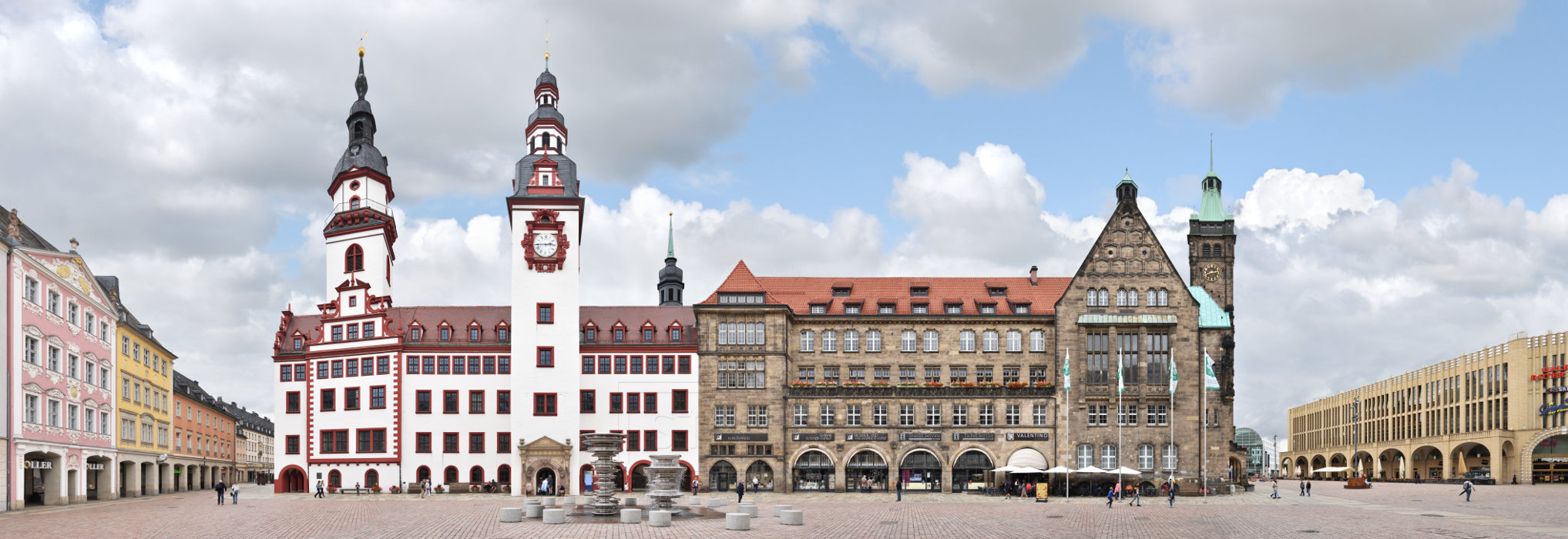Double Town Hall Chemnitz
Our Streetline Panorama shows the Old Town Hall on the left and the New Town Hall of Chemnitz on the right. This is why we speak of a double town hall (Doppelrathaus) in the industrial metropolis of Saxony. The Old Town Hall was built as early as the late 15th century, while the New Town Hall was added in the early 20th century. What is little known today, Chemnitz got two more “Old New Town Halls” in the 19th century, which already no longer exist. In the growing city, the Higher Citizens’ School on Postplatz first became the New Town Hall in 1879 and this received a now “New Town Hall” as an extension on Beckerplatz in 1891. Both buildings were destroyed in the Second World War and later demolished. But let us return to the existing town halls (alternatively City Hall) on Chemnitz’ market square.
The Old Town Hall
The Old Town Hall was built next to St. Jacob’s Church, whose tower can be seen in the background in the centre of the picture. After several wooden predecessor buildings, a new late Gothic building was erected between 1496 and 1498, projecting into the market square. Even this was not spared from fires and it was repeatedly rebuilt and reconstructed. In the process, the High Tower, on the left in the picture, was built in 1620. Around 1746, the Freiberg council carpenter Johann Gottlieb Ohndorff created the present baroque state.
The Judith Lucretia portal from 1559 at the entrance to the Old Town Hall is remarkable. It was located on the so-called “Neefesche Haus” until 1910. Today, a figurative carillon can once again be found above the portal. After the destruction of the war, the Old Town Hall was rebuilt between 1947 and 1951. A historical view on Wikipedia shows that the Old Town Hall was raised by one storey. The Old Town Hall is the seat of the mayor’s office.
The New Town Hall
The rapid growth of Chemnitz as an industrial metropolis led to plans for a new town hall on the market square at the beginning of the 20th century. The New Chemnitz Town Hall was finally built between 1907 and 1911 according to plans by the town architect Richard Möbius. It is symmetrical with the Old Town Hall and features elements of the Art Nouveau style. The interior of the town hall is completely in Art Nouveau style and the Leipzig artist Max Klinger created the mural “Arbeit = Wohlstand = Schönheit” (Work = Prosperity = Beauty) for the town council chamber in 1918.
Remarkable is the 4.75 m high Roland figure created by the Dresden sculptor Alexander Höfer – as a corner figure it characterises the view of the New Town Hall from the market (see detailed pictures). It is also remarkable that the New Town Hall survived the destruction of Chemnitz’s city centre almost unscathed, while practically all the buildings in the centre, including the directly adjacent Old Town Hall, were either badly damaged or destroyed.
The New Town Hall Tower has been home to a carillon since 1978, which plays on Wednesdays and Saturdays from 10.00 to 10.30 all year round.
Chemnitz is the European Capital of Culture in 2025.


